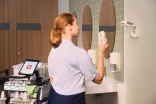Home › magazine › web article › latest news › Air freshening smart dispensing
Air freshening - smart dispensing
9th of October 2025Light sensors, motion detectors, metered dispensing, nano-technology …… today’s air freshener systems are becoming smarter all the time. Ann Laffeaty considers the benefits of the latest air freshener technology and finds out whether more traditional formats still have a place in the industry.
THERE WAS ONCE A TIME when air freshener systems generally came in one of two formats. Either the fragrance was dispensed manually from a spray can, or it was diffused into the atmosphere via a tab hanging in one’s home or car.
But technology has moved on from such traditional solutions and many of today’s products are light years away from those familiar products of the past.
But why? Are spray cans and hanging tabs no longer sufficiently effective to be viable solutions? They certainly have their disadvantages, according to P-Wave brand manager at Robert Scott Mark Wintle.
“While most tab air fresheners are cost-effective upfront, they lack the power to meaningfully fragrance a space,” he said. “And spray cans can carry hidden costs while also giving rise to environmental concerns.”
Spray cans are also often wasteful, according to Wintle. “The fact that dispensing isn’t always controlled can lead to potential overuse,” he explains. “Waste management also becomes a complex issue because aerosols need to be stored and disposed of as hazardous waste.
“They have sustainability issues too, because many will end up in landfill and few are recycled. And refill tracking and usage can be difficult to predict with a spray can, and this complicates the picture with regards to budgeting and stock control.”
Wintle says the industry is evolving rapidly and many manufacturers are moving away from the more traditional air freshening systems. “New solutions prioritise sustainability, automation, simplicity and compliance,” he adds. “They include passive fragrance systems that release scent consistently without propellants or batteries as well as dispensers that have programmable or motion/light sensors for controlled use.
“There are recyclable, polymer-based systems available as well such as EVA air fresheners that reduce environmental impact. And some innovations are even exploring nano-diffusion for a highly-targeted fragrance delivery designed to reduce the effects of nose blindness.”
Robert Scott offers aerosol-free fragrance solutions that are said to be both sustainable and simple to use.
P-Wave products employ no aerosols and are claimed to release the fragrance consistently, avoiding ‘scent spikes’ while ensuring that the room always smells fresh. The wall-mountable units use recyclable EVA-based materials and are available in both powered and passive formats.
Smart and data-driven
Air freshening is likely to become even more sophisticated in the years ahead, predicts Wintle. “The future of air freshening is smart, sustainable and data-driven,” he said. “We expect to see more connected dispensers that monitor fragrance levels and send refill alerts along with a more widespread use of biodegradable materials plus closed-loop recycling schemes. And customisable scent profiles will increasingly be linked to user behaviour or even brand identity.”
Traditional tab and aerosol spray can air fresheners are still widely used in many environments, according to operations director at Principle Cleaning Sylwia De Sousa. “However, they are becoming less acceptable in environmentally-conscious settings,” she adds. “At Principle we continuously review our products and practices to ensure they align with our sustainability goals. Given the environmental concerns around propellants, single-use containers and uncontrolled usage these older solutions are no longer our preferred choice.”
Inconsistent performance
The uncontrolled dispensing associated with spray cans can result in overuse and an inconsistent performance, she says. “The environmental footprint of aerosol propellants along with the
single-use plastic or metal containers plus the chemicals used in some formulations is significant,” she said. “Aerosols can also be less cost-predictable over time, particularly where usage is high or where product maintenance is not being closely monitored.”
Many manufacturers have embraced newer, smarter technologies as a result, she says. “These include systems with light or motion sensors, programmable metered dispensing and even nano-technology to release fragrance more efficiently and evenly,” she said. “There is also a move towards non-aerosol, refillable and biodegradable solutions as well as products that use natural essential oils over synthetic chemicals.”
Smart air freshening systems work by releasing scent only where it is needed such as where motion or light detection indicates a room is occupied, said De Sousa. “Metered dispensers ensure that fragrance release is both controlled and consistent, and this reduces waste and improves cost-efficiency,” she said.
As environmental awareness grows she expects to see a wider use of AI-driven scent delivery systems in the future. “These will be able to adapt to usage patterns, air quality and room size,” she said. “Future developments may also include Internet of Things integration to enable remote monitoring and refilling alerts, along with environmentally-reactive systems that respond to temperature or humidity changes. The industry is moving toward data-informed and zero-waste solutions and we are committed to evolving alongside it.”
Essity communications director Jenny Turner agrees with other commentators that many businesses are moving away from traditional tab and spray can systems. “These are increasingly being seen as outdated because they often lack consistency and control - factors that have become essential in modern hygiene management,” she said.
“When fragrance dispersal is more difficult to control, usage becomes less predictable and this can lead to higher long-term costs.”
She says the industry is continually creating more advanced, sustainable and consistent solutions. The company’s own Tork Constant Air Freshener uses a patented passive fragrancing system designed to deliver a continuous scent without the need for batteries, propellants or sensors.
Not living up to the hype
Aerosols have long been the obvious solution for most air treatment, room fragrancing and olfactory marketing needs, says Prodifa’s commercial export manager Séverine Bossaert.
“They offer a number of advantages such as quality, cost-effectiveness and facility of use,” she said. “The only constraints on aerosols concern the safety regulations on formulation, transport and usage along with environmental regulations. The rules around raw materials, recyclability and product disposal are constantly evolving and pulling all manufacturers upwards - and that’s a very good thing.” Prodifa’s aerosols have a steel casing and a PET plastic cap and are up to 95 per cent recyclable.
Some of today’s ‘smart’ air freshening solutions are not living up to their hype, according to Bossaert. “After an encouraging start, automatic dispensers using light-sensitive cells have proved to be ineffective because no indoor public space provides the lumens required for them to work properly,” she claims. “Motion detector devices are unsuitable for professional use and electric piezzo diffusers are unreliable and require frequent maintenance. And the technology of these devices is far too costly and environmentally-damaging to use.”
Prodifa’s NEBULIBOX range of devices are said to diffuse fragrance in a dry mist over an area of up to 5000 cubic metres. Aimed at shopping centres, hotels, spas and gyms they are claimed to have a low environmental footprint and are programmable via wifi or Bluetooth.
Aerosols are unable to provide a consistent level of fragrance because their heavy particles tend to fall quickly to the ground, says Vectair’s vice-president of marketing Chelsey Schwartz. “This leads to an uneven scent distribution and a noticeable loss of fragrance in the room,” she said.
“Aerosols also contain propellants which raise environmental concerns. And the required disposal methods for the hazardous content can lead to additional costs.”
Innovative companies are looking at new methodologies that improve fragrance performance while also reducing environmental impact, she says. “Technologies such as light sensors and motion detectors are becoming more common to conserve energy and reduce unnecessary fragrance and power use,” said Schwartz.
“Other methods focus on creating finer fragrance particles that hang in the air for longer and that create a layering effect between sprays. And organisations are looking at ways of bringing the best of active and passive systems together in order to create an innovative hybrid air care approach.”
Vectair’s Vibe Pro incorporates patented precision dosing and vibrating mesh technologies said to create a fine, ultra-light mist. And the company’s V-Air Flow is made from eco-friendly materials and uses a fan-driven Venturi airflow to deliver 83,000 microbursts in 30 days.
Simplicity advantage
Like Wintle, Schwartz believes consumer demand will result in the industry offering more sustainable, smarter solutions. “With regulatory changes on a regular basis we will see greater innovation in materials, IoT integration and AI-based scent scheduling,” she said. “The future will be smarter, greener and brighter.”
So as the industry moves on, is there still a place for those traditional tab and spray can solutions?
The simplicity of the spray can means many are still in use today, says Schwartz. “We continue to sell our Airoma product line to support customers in environments where this is still an effective solution,” she said. “However, we are seeing a shift towards more innovative systems due to expectations around environmental responsibility.”
Principle Cleaning’s Sylwia De Sousa says tabs and spray solutions have the advantage of being simple and cost-effective. “They are tried and tested - they offer quick deployment and are easy to replace, making them appealing in some high-traffic or lower-priority areas,” she said.
Dynamic market
The aerosol market is dynamic, growing and changing, says Prodifa’s Séverine Bossaert. “Traditional methods are not being abandoned, but are evolving and adapting to meet the needs of an ever-increasing number of users and adhere to environmental challenges,” she said.
Robert Scott’s Mark Wintle says traditional air freshener systems have the advantage of being affordable, portable and easy to use and install. “They are trusted by facilities teams who have been using them for decades, and this has kept them in circulation - particularly in smaller or lower-footfall spaces,” he said.
However, he adds that traditional formats are coming under increasing scrutiny in commercial settings. “The fact that aerosol-based systems are now being treated as hazardous waste due to their flammable and pressurised contents means businesses need to handle and dispose of them carefully, which adds compliance complexity,” he said. “And as legislation on recycling and digital waste tracking tightens, many organisations are beginning to re-evaluate their options.”










